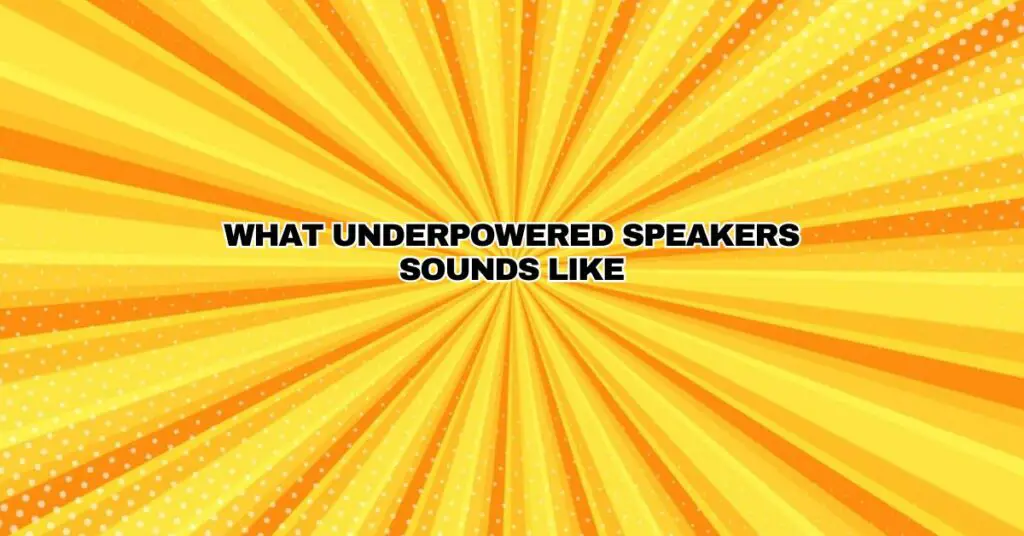In the world of audio systems, the interaction between amplifiers and speakers is crucial in achieving the perfect balance of sound quality. However, the scenario of underpowered speakers is a concern for audiophiles and enthusiasts. This comprehensive article embarks on a journey to explore the intricacies of underpowered speakers, unveiling the symptoms and sonic characteristics that define their performance. We aim to answer the question: What do underpowered speakers sound like, and how do they impact the listening experience?
Read Also : Over-powered vs under-powered
Table of Contents:
- Introduction: The Significance of Amplifiers and Speakers
- The Harmony of Audio Systems
- The Underpowered Speaker Conundrum
- Amplifiers and Speakers: A Symbiotic Relationship
- The Role of Amplifiers
- The Essence of Speakers
- The Importance of Matching
- Understanding Underpowered Speakers
- Definition and Causes
- Symptoms of Underpowered Speakers
- The Impact on Sound Quality
- The Sonic Characteristics of Underpowered Speakers
- Distorted Sound
- Clipping and Overloading
- Limited Dynamic Range
- Speaker Protection and Longevity
- Risks to Underpowered Speakers
- Methods of Protection
- Speaker Longevity
- Subjective Sound Perception
- Personal Listening Preferences
- Musical Genres and Applications
- The Role of Room Acoustics
- Debunking Myths and Misconceptions
- The “Amplifiers Can Do It All” Fallacy
- Evaluating Power vs. Performance
- Making Informed Choices: Avoiding Underpowered Systems
- Calculating Power Requirements
- Amplifier and Speaker Selection
- Room Acoustics Considerations
- Conclusion: Unmasking the True Potential
- Achieving Sonic Harmony
- Personalizing the Listening Experience
Chapter 1: Introduction: The Significance of Amplifiers and Speakers
This chapter introduces the critical role of amplifiers and speakers in audio systems and outlines the underpowered speaker dilemma.
Chapter 2: Amplifiers and Speakers: A Symbiotic Relationship
Readers will gain an understanding of the synergy between amplifiers and speakers, including the functions and importance of matching them correctly.
Chapter 3: Understanding Underpowered Speakers
This section defines underpowered speakers, explores their causes, and highlights the symptoms and their impact on sound quality.
Chapter 4: The Sonic Characteristics of Underpowered Speakers
The chapter delves into the distinct sonic characteristics of underpowered speakers, including distorted sound, clipping, overloading, and limited dynamic range.
Chapter 5: Speaker Protection and Longevity
Readers will learn about the potential risks to underpowered speakers, methods of protection, and strategies for ensuring speaker longevity.
Chapter 6: Subjective Sound Perception
This section discusses the subjectivity of sound perception, considering personal listening preferences, musical genres, applications, and the role of room acoustics.
Chapter 7: Debunking Myths and Misconceptions
Common myths and misconceptions surrounding amplifiers and speakers are debunked, challenging the belief that amplifiers can compensate for underpowered speakers.
Chapter 8: Making Informed Choices: Avoiding Underpowered Systems
Practical advice is offered on avoiding underpowered systems by calculating power requirements, selecting appropriate amplifiers and speakers, and considering room acoustics.
Chapter 9: Conclusion: Unmasking the True Potential
The conclusion summarizes the key takeaways, emphasizing the achievement of sonic harmony and the importance of personalizing the listening experience.
Conclusion: Unmasking the True Potential
In the quest for audio perfection, the relationship between amplifiers and speakers is pivotal, and the scenario of underpowered speakers is a concern that can impact the listening experience. This comprehensive exploration has unveiled the symptoms and sonic characteristics of underpowered speakers, shedding light on their performance and the critical importance of addressing this issue.
Amplifiers and speakers have a symbiotic relationship, each playing a crucial role in sound reproduction. The scenario of underpowered speakers, defined by a lack of sufficient amplifier power, can result in distinct sonic characteristics. These characteristics include distorted sound, clipping, overloading, and a limited dynamic range, which can significantly diminish the listening experience.
Underpowered speakers also face risks, including the potential for damage and reduced longevity. Protection methods can be employed to safeguard speakers and prolong their lifespan. Sound perception is a highly subjective realm, shaped by personal listening preferences, musical genres, applications, and room acoustics.
The myth that amplifiers can compensate for underpowered speakers is debunked, as the synergy between amplifiers and speakers is essential for optimal performance. Making informed choices involves calculating power requirements, selecting amplifiers and speakers that match, and considering room acoustics to ensure a balanced audio system.
Ultimately, the unmasking of the true potential of speakers involves achieving sonic harmony by addressing underpowered scenarios and personalizing the listening experience to align with individual tastes and aspirations.


